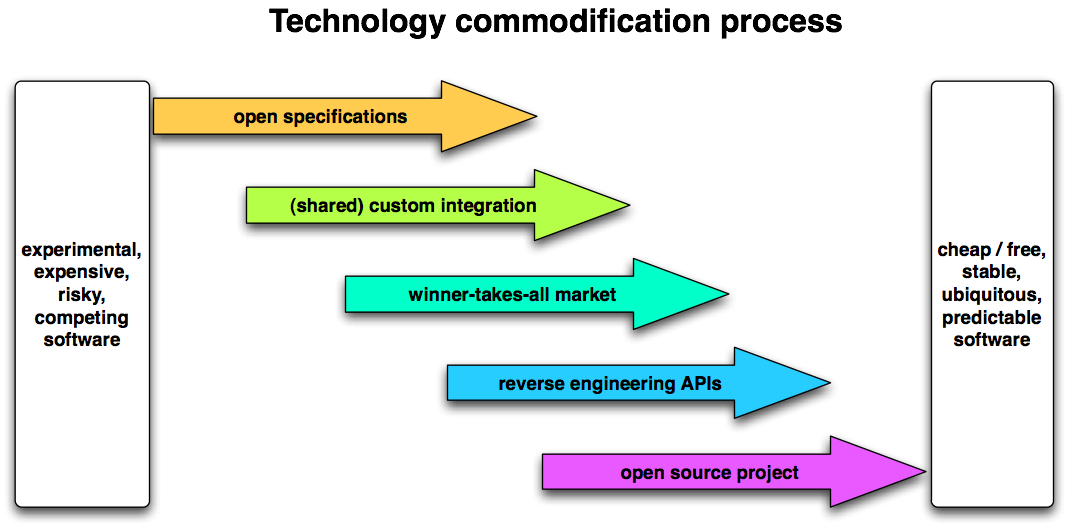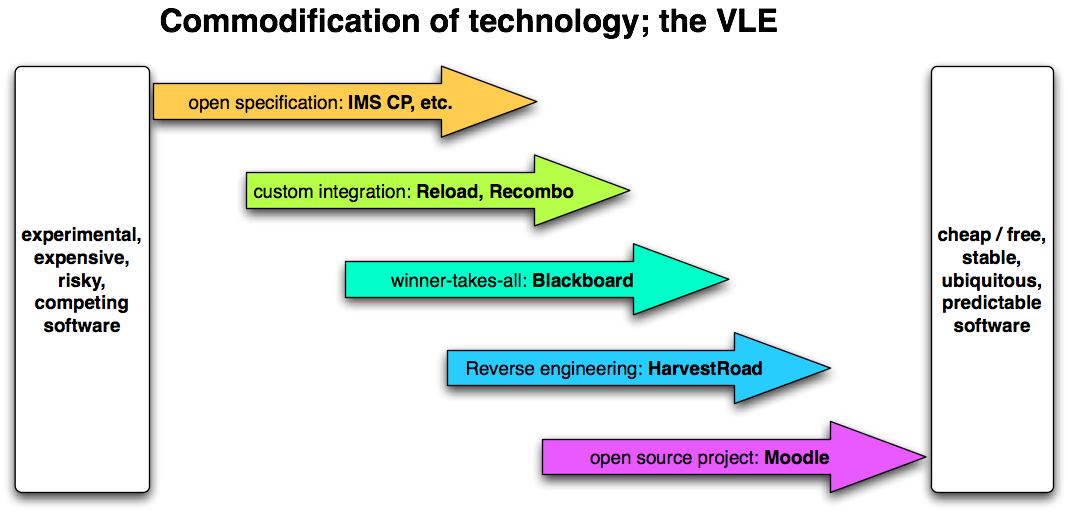Control of a technology may seem a vendor business: Microsoft and Windows, IBM and mainframes. But by understanding how technology moves from prototype to ubiquity, the people who foot the bill can get to play too.
Though each successful technological innovation follows its own route to becoming an established part of the infrastructure, there are couple of regularities. Simplified somewhat, the process can be conceived as looking like this:

The interventions (open specifications, custom integration et al) are not mutually exclusive, nor do they necessarily come in a fixed chronological order. Nonetheless, people do often try to establish a specification before the technology is entirely ‘baked’, in order to forestall expensive dead-ends (the GSM mobile phone standard, for example). Likewise, a fully fledged open source alternative can take some time to emerge (e.g. mozilla / firefox in the web browser space).
The interventions themselves can be done by any stakeholder; be they vendors, buyers, sector representatives such as JISC or anyone else. Who benefits from which intervention is a highly complex and contextualised issue, however. Take, for example, the case of VLEs:
When VLEs were heading from innovation projects to the mainstream, stakeholders of all kinds got together to agree open standards in the IMS consortium. No-one controlled the whole space, and no-one wanted to develop an expensive system that didn’t work with third party tools. Predictably, implementations of the agreed standards varied, and didn’t interoperate straight off, which created a niche for tools such as Reload and course genie which allowed people to do some custom integration; a glossing over the peculiarities of different content standard implementations. Good for them, but not optimal for buyers or the big vle vendors.
In the mean time, some VLE vendors smelled an opportunity to control the technology, and get rich off the (license) rent. Plenty of individual buyers as well as buyer consortia took a conscious and informed decision to go along with such a near monopoly. Predictability and stability (i.e. fast commodification) were weighed against the danger of vendor lock-in in the future, and stability won.
When the inevitable vendor lock-in started to bite, another intervention became interesting for smaller tool vendors and individual buyers: reverse engineering. This intervention is clearer in other technologies such Windows file and print server protocols (the Samba project) and the PC hardware platform (the early ‘IBM clones’). Nonetheless, a tool vendor such as HarvestRoad made a business of freeing content that was caught in proprietary formats in closed VLEs. Good for them, not optimal for big platform vendors.
Lastly, when the control of a technology by a platform becomes too oppressive, the obvious answer these days is to construct an open source competitor. Like Linux in operating systems, Firefox in browsers or Apache in webservers, Moodle (and Sakai, atutor, .LRN and a host of others) have achieved a more even balance of interests in the VLE market.
The same broad pattern can be seen in many other technologies, but often with very particular differences. In blogging software, for example, open source packages have been pretty dominant from the start, and one package even went effectively proprietary later on (Movable Type).
Likewise, the shifting interests of stakeholders can be very interesting in technologies that have not been fully commodified yet. Yahoo for example, has not been an especially strong proponent of open specifications and APIs in the web search domain until it found itself the underdog to Google’s dominance. Google clearly doesn’t feel the need to espouse open specifications there, since it owns the search space.
But it doesn’t own mobile phone operating systems or social networking, so it is busy throwing its weight behind open specification initiatives there. Just as they are busy reverse engineering some of Microsoft’s technologies in domains that have already commodified such as office file formats.
From the perspective of technology users and sector representatives, it pays to consider each technology in a particular context before choosing the means to commodify it as advantageously but above all as quickly as possible. In the end, why spend time fighting over technology that is predictable, boring and ubiquitous when you can build brand new cool stuff on top of it?

Pingback: Techno-fil (30/07/08) « pintiniblog
Pingback: Wilbert’s work blog» Blog Archive » Approaches to building interoperability and their pros and cons
Pingback: Wilbert’s work blog» Blog Archive » VLE commodification is complete as Blackboard supports Moodle and Sakai
Pingback: Blackboard’s new open source strategy: how virtual learning environments became commodities « « DediCommDediComm